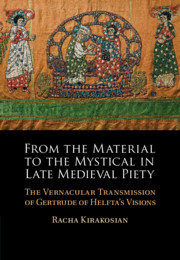 From the Material to the Mystical in Late Medieval Piety
From the Material to the Mystical in Late Medieval Piety Book contents
- From the Material to the Mystical in Late Medieval Piety
- From the Material to the Mystical in Late Medieval Piety
- Copyright page
- Dedication
- Contents
- Illustrations
- Acknowledgements
- Note on the Maps
- Introduction
- One The Helfta Scriptorium
- Two Redactions within a Dynamic Textuality
- Three Manuscript Transmission History
- Four The Book’s Self-Reflectivity
- Five The Scriptorial Heart
- Six Imaginary Textiles
- Final Remarks
- Book part
- Notes
- Bibliography
- Index
Two - Redactions within a Dynamic Textuality
Published online by Cambridge University Press: 01 September 2021
- From the Material to the Mystical in Late Medieval Piety
- From the Material to the Mystical in Late Medieval Piety
- Copyright page
- Dedication
- Contents
- Illustrations
- Acknowledgements
- Note on the Maps
- Introduction
- One The Helfta Scriptorium
- Two Redactions within a Dynamic Textuality
- Three Manuscript Transmission History
- Four The Book’s Self-Reflectivity
- Five The Scriptorial Heart
- Six Imaginary Textiles
- Final Remarks
- Book part
- Notes
- Bibliography
- Index
Summary
Redactorial activities continued to influence the transmission of the Legatus; although the vernacular ‘community’ of redactors did not live together in a convent nor even necessarily at the same time, the composition of the different texts is as collaborative, iterative, and myriad as the Latin text versions – of which we now know more than one. Having discussed Helfta’s writing culture, I now turn to the question of the textual status of the vernacular redactions of the Legatus, first revisiting previous research on the botte before moving on to discuss new insights into multilingual activities in late medieval female convents, and their interest in copying the botte. On the basis of critical observations of texts and sources, I contend that the Legatus was rendered into the German botte by Carthusian monks in the fourteenth century (the Trutta-legend as a redaction by Dominican nuns will be discussed in Chapter 3 where I examine the reform context). In the current chapter, I look at theoretical issues which accompany the study of the botte and contextualise the concept of redaction in its literary tradition by referring to medieval ideas about literary activities, especially those developed by Bonaventure (1217–74). With the focus of inquiry on conceptual problems, this exploration is not intended to be exhaustive but rather generative as it invites debates on the status of vernacular redactions. In the latter half of this chapter, I suggest a new approach to the botte – inspired by ideas from Material Philology – which highlights the dynamic nature of a manuscript culture. Taking in particular Christopher Baswell’s notion of a generative readership into account, I argue that we ought to think of the botte as a ‘redaction’ in the sense of the medieval term, which encompasses improvement, interpretation, and innovation. The term ‘redaction’ has already been employed to describe the botte; investigating the term’s meaning for the status of a translation in relation to its Latin model evinces innovative ways to think about vernacular texts in the late Middle Ages highlighting their dynamic textuality.
- Type
- Chapter
- Information
- From the Material to the Mystical in Late Medieval PietyThe Vernacular Transmission of Gertrude of Helfta's Visions, pp. 33 - 63Publisher: Cambridge University PressPrint publication year: 2021
